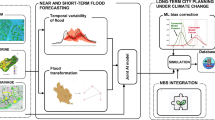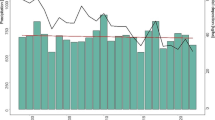Abstract
In this study a water consumption model is built into a scenario-based planning support system (SB-WCPSS). The SB-WCPSS consists of four components—(1) a model input graphic user interface, (2) a community spatial database, (3) a set of drinking water consumption models, and (4) output display. The SB-WCPSS is implemented with a commercial planning support system software package—CommunityViz. The model is applied using data in Cincinnati, Ohio, USA to demonstrate the scenario development. In the application, water consumption consists of land use based indoor, turf, and pool water usages. Climate change is reflected in monthly temperature and precipitation. By specifying anticipated future land uses and associated water consumption rates, temperature, and precipitation, SB-WCPSS users can analyze and compare water consumptions under various scenarios, using maps, graphs, and tables. Parcel-based daily water consumptions were computed and summarized spatially by neighborhood, block group, or land use type. The results demonstrate that water conservation strategies, such as xeriscape, can reduce turf water usage. Indoor water consumption depends on the number of people who use water and how they use water. The study shows that the SB-WCPSS structure is sound and user friendly. Future improvement will be on enhancing various components, such as using parcel-based data and more robust water consumption models. The system may be used by water resource managers and decision makers to adapt water resources (e.g., watersheds and infrastructure) to climate change and demographic and economic development.













Similar content being viewed by others
References
American Water Works Association Research Foundation (AWWARF) (1999) Residential water use summary 1999. http://www.aquacraft.com/Publications/residents.htm. Accessed 3 May 2010
Avin UP, Dembner JL (2001) Getting scenario-building right. Planning 67(11):22–27
Balling RC Jr, Gober P (2007) Climate variability and residential water use in the city of Phoenix, Arizona. J Appl Meteorol Climatol 46:1130–1137
Burgess A (2010) Promoting domestic water conservation through the utilization of a scenario-based planning support system. Master’s THESIS. University of Cincinnati, Cincinnati
Computer Support Group, Inc (2009) Water consumption calculator. Computer Support Group. http://www.csgnetwork.com/waterusagecalc.html. Accessed 31 Oct 2009
Cooley H, Hutchins-Cabibi T, Cohen M, Gleick PH, Herberger M (2007) Hidden Oasis: water conservation and efficiency in Las Vegas. Pacific Institute and Western Resource Advocates, Oakland
Cummings R (2007) Engaging the public through narrative based scenarios. In: Hopkins LD, Zapata MA (eds) Engaging the future: forecasts, scenarios, plans, and projects. Lincoln Institute of Land Policy, Cambridge, pp 243–260
Dandy G, Nguyen T, Davies C (1997) Estimating residential water demand in the presence of free allowances. Land Econ 73(1):125–139
Deviney FA Jr, Brown DE, Rice KC (2012) Evaluation of bayesian estimation of a hidden continuous-time Markov chain model with application to threshold violation in water-quality indicators. J Environ Inform 19(2):70–78
Fletcher TD, Deletic A (2008) Data requirements for integrated urban water management. UNESCO, Paris
Geertman S, Stillwell J (2003) Planning support systems: an introduction. In: Geertman SS, Stillwell J (eds) Planning support systems in practice. Springer, New York, pp 3–22
Greater Cincinnati Water Works (2010) Monthly aggregate water consumption. Greater Cincinnati Water Works, Cincinnati
Guhathakurta S, Gober P (2007) The impact of the phoenix urban heat island on residential water use. J Am Plan Assoc 73(3):317–329
Guo P, Huang GH (2009) Two-stage fuzzy chance-constrained programming: application to water resources management under dual uncertainties. Stoch Environ Res Risk Assess 23:349–359
Hopkins LD, Zapata MA (2007) Engaging the future: forecasts, scenarios, plans and projects. Lincoln Institute of Land Policy, Cambridge
Randolph J (2004) Environmental land use planning and management. Island Press, Washington, DC
Kenny JF, Barber NL, Hutson SS, Linsey KS, Lovelace JK, Maupin MA (2009) Estimated use of water in the United States in 2005. United States Geological Survey, Reston
Klosterman RE (2001) Planning support systems: a new perspective on computer-aided planning. In: Brail RK, Klosterman RE (eds) Planning support systems: integrating geographic information systems, models, and visualization tools. ESRI Press, Redlands
Klosterman RE (2007) Deliberating about the future. In: Hopkins LD, Zapata MA (eds) Engaging the future: forecasts, scenarios, plans, and projects. Lincoln Institute of Land Policy, Cambridge, pp 199–220
Li YP, Huang GH, Chen X (2009) Multistage scenario-based interval-stochastic programming for planning water resources allocation. Stoch Environ Res Risk Assess 23:781–792
Li YP, Huang GH, Nie SL (2010) Planning water resources management systems using a fuzzy-boundary interval-stochastic programming method. Adv Water Resour 33:1105–1117
Li YP, Huang GH, Nie SL, Chen X (2011) A robust modeling approach for regional water management under multiple uncertainties. Agric Water Manag 98:1577–1588
Liu Z, Tong TY (2011) Using HSPF to model the hydrologic and water quality impacts of riparian land-use change in a small watershed. J Environ Inform 17(1):1–14
National Weather Service (2010) Archived climate data—NWS Wilmington. http://www.erh.noaa.gov/iln/lcdpage.htm. Accessed 20 Feb 2010
Schreck B, Farber H (2009) A water supply crisis or a water management crisis? J Am Water Works Assoc 33:458–469
Sipes JL (2003) Visualizing community form. Landsc Archit 93:56–97
Southern Nevada Water Authority (2008) Pools and spa tips. Southern Nevada Water Authority. http://www.snwa.com/html/cons_tips_pool/html. Accessed 15 Dec 2009
Sovocool KA (2005) Xeriscape conversion study final Report. Southern Nevada Water Authority. http://www.snwa.com/assets/pdf/xeri_study_final.pdf. Accessed 15 Dec 2009
Sovocool KA, Morgan M, Bennett D (2006) An in-depth investigation of xeriscape as a water conservation measure. American Water Works Association Journal 98(2):82–93
The Orton Family Foundation (2004) An introduction to GIS planning support software, version 1.0. The Orton Family Foundation, Boulder
Troy P, Holloway D (2004) The use of residential water consumption as an urban planning tool: a pilot study in Adelaide. J Environ Plan Manag 47(1):97–114
United States Environmental Protection Agency (2009) water resource adaptation program. http://www.epa.gov/nrmrl/wswrd/wqm/wrap/. Accessed 30 April 2009
Vickers A (2001) Handbook of water use and conservation. Water Plow Press, Amherst
Wang S, Huang GH, Lu HW, Li YP (2010) An interval-valued fuzzy linear programming with infinite a-cuts method for environmental management under uncertainty. Stoch Environ Res Risk Assess 25:211–222
Zhao H, Zhang J, James RT, Laing J (2012) Application of MIKE SHE/MIKE 11 model to structural BMPs in S191 Basin, Florida. J Environ Inform 19(1):10–19
Acknowledgments
The U.S. Environmental Protection Agency, through its Office of Research and Development, funded and managed, or partially funded and collaborated in, the research described herein. It has been subjected to the Agency’s administrative review and has been approved for external publication. Any opinions expressed in this paper are those of the author(s) and do not necessarily reflect the views of the agency; therefore, no official endorsement should be inferred. Any mention of trade names or commercial products does not constitute endorsement or recommendation for use. The authors are very grateful to the editors and the anonymous reviewers for their insightful comments and suggestions.
Author information
Authors and Affiliations
Corresponding author
Rights and permissions
About this article
Cite this article
Wang, X., Burgess, A. & Yang, J. A scenario-based water conservation planning support system (SB-WCPSS). Stoch Environ Res Risk Assess 27, 629–641 (2013). https://doi.org/10.1007/s00477-012-0628-3
Published:
Issue Date:
DOI: https://doi.org/10.1007/s00477-012-0628-3




